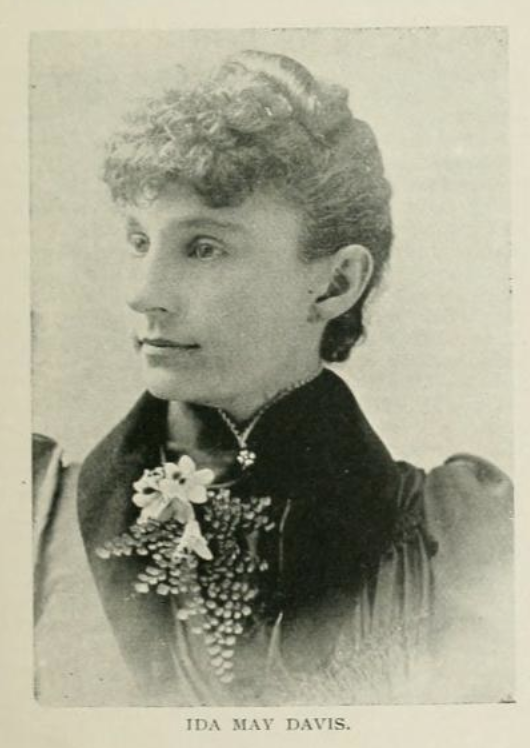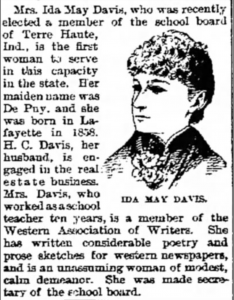
Plan your visit
The Extremely Unlikely Election of Ida May Davis
March 19, 2020

It’s the small sketch that catches my eye first, buried in the middle of a packed 1891 newspaper. Illustration is hard to come-by in gazettes of this era, and a female subject is even rarer. “Terre Haute Takes the Lead” emblazons the title, sending me down a research rabbit hole to uncover the trailblazer with a relatively ordinary name: Ida May Davis, possibly the first woman elected in Indiana almost thirty years before women gain the right to vote.*
Davis was a teacher, writer, and poet. Born Ida May De Puy around 1858 in Lafayette, she was described as vivacious, with a quick sense of humor. Davis was a born writer, excelling in rhyming poetry, vivid prose, and painting. She published her first poem at 16, and a steady stream of work continued to appear in newspapers through the mid-west and western states for most of her life.
By 1876, Davis was living in Terre Haute and teaching school, after marrying Civil War veteran, businessman, and train dispatcher Henry Clay (H.C.) Davis. She’s called the center of local literary circles. Her writings were often published in the papers, where she is described with great flourish as a “talented poetess.”
Fast forward fifteen years and Davis has taught in Terre Haute schools for over 10 years when she is nominated to the School Board of Trustees. It sounds like her victory was a surprise to anyone reading the Terre Haute Daily News election results, and even to Davis herself.
In 1891, school boards in Terre Haute were elected by the City Council. That evening saw a bit of dramatics, with Ida being pitted against the Republican caucus-chosen nominee J. Q. Button. When it came to the vote, a combination of five Democratic councilors and one rouge Republican voted in favor of Davis, while the remaining six Republicans voted for Button. The tie vote then went to Mayor James Allen, who with “gallantry, and in deference to the wishes democratic cohorts” elected Davis. She was promptly made secretary of the school board.
 According to local reporters, the responses to her election are surprisingly supportive, generally agreeing that Davis was well suited to fill the position. “Mrs. Davis is in every way able to fill the position,” supported the Logansport Pharos-Tribune, (June 4, 1891). The Saturday Evening Mail went so far as to call the election an “innovation,” and that her “knowledge of school affairs is such that she can vote intelligently on all questions which come before her, which is more than can be said of many men who have held even less important positions.”
According to local reporters, the responses to her election are surprisingly supportive, generally agreeing that Davis was well suited to fill the position. “Mrs. Davis is in every way able to fill the position,” supported the Logansport Pharos-Tribune, (June 4, 1891). The Saturday Evening Mail went so far as to call the election an “innovation,” and that her “knowledge of school affairs is such that she can vote intelligently on all questions which come before her, which is more than can be said of many men who have held even less important positions.”
For being a seminal moment for women’s political means in the state, Davis’ election was met with little fanfare, though reports of the election made appearances in papers, as far as San Francisco California and to Davenport Iowa and New York. (See a selection of papers here.)
Ultimately, Ida went on to be chair of the school board by 1893, but only served one term, not seeking reelection. (Saturday Evening Mail, June 2, 1894, p5). Within a few years, she and her husband moved to Huntington, until he passed away in 1898. She would run for a few more offices, including State Librarian, with no success. Davis lives twenty more years, passing away in 1910 and is buried in Fairfield, WI.
Over the next three decades, Hoosier women like Mary Nicholson and Virginia Brooks used school board seats as a stepping stone to full voting rights. Today women hold 40% of seats on school boards in Indiana, compared to just 24% of the state legislature.
Want to learn more about Indiana’s 100th anniversary commemoration of suffrage? Check out how we and our friends are remembering the fight, order your copy of our new book We Must Be Fearless by Anita Morgan, or keep an eye out for more events coming soon.
* Indiana’s women’s history and our Hoosier heroines, especially in the first half of our state’s history are sorely under researched. If you know of another woman who was elected in Indiana before 1891, by popular vote or a city council of men, please let us know. We’d love to find ways to share their stories.









